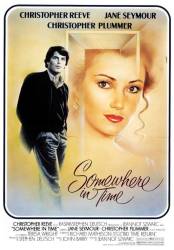
Continuity mistake: When Reeves signs the guest register at the hotel in 1912, his signature is different from the one that he saw in the register that he found in the attic.
Continuity mistake: During their "picnic" in the hotel room, Elise asks Richard what time it is. As he says that he doesn't care, his hands are both down and out of frame. When the angle changes, his right hand is suddenly raised to chin level, holding the champagne glass, with no time for a natural transition to that pose. (01:30:00)
Continuity mistake: When Richard Collier is leaving Chicago near the beginning of the film, he is seen driving past the John Hancock Tower. The sky is overcast and the clouds so low that the top of the building cannot be seen. In the next shot, however, skies are partly cloudy and the building can be seen in its entirety.
Continuity mistake: When he's tied up in the stable, Richard knocks down and breaks a lantern to cut himself free. He then sits directly in front of it to cut his bonds, and doesn't move to either side before standing up. When he does stand, though, the broken lantern is suddenly more than a foot to his left instead of behind him. (01:24:25)
Continuity mistake: When Richard is first speaking into his tape recorder in his hotel room, there is a beige "touchtone" telephone in the background. When Arthur is using the telephone at the end of the movie, it has changed into a rotary dial phone (it is evident when you hear Arthur dial 0 for the hotel operator).
Continuity mistake: Near the end of the movie, C. Reeve is seated at a table on the lawn, and C. Plummer approaches, with the intent of encouraging C. Reeve to leave town. As they are talking, the camera goes back and forth between them. Whenever the camera is focused on C. Reeve, he is enjoying either a full meal or a cup of coffee.
Continuity mistake: After Richard cuts his hair, it goes back to its original length at least three times during the movie. (00:30:10 - 01:24:10)






Answer: He was no longer able to put everything out of his mind, which was a requirement to successfully time-travel. He was distraught and unable to focus enough mentally. He stopped eating, and as time went on he became weaker and weaker.